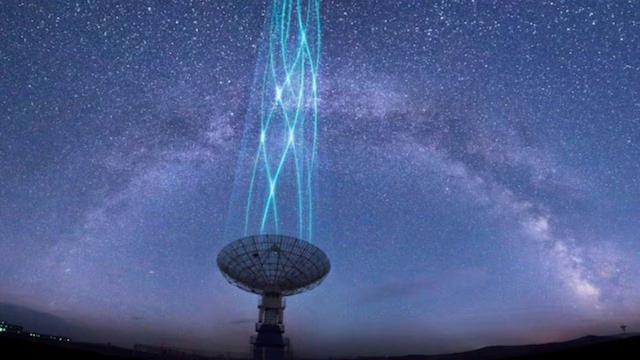A mysterious and powerful burst of radio waves has reached Earth after traveling through space for 8 billion years, according to a new study published in Science. This signal, known as FRB 20220610A, is one of the most distant and energetic radio signals ever detected. It provides scientists with a unique opportunity to study the universe’s distant past.
What Are Fast Radio Bursts (FRBs)?
Fast radio bursts (FRBs) are brief, intense pulses of radio waves that last only milliseconds. Since their discovery in 2007, these enigmatic signals have intrigued scientists. Their origins remain a cosmic mystery, with theories ranging from neutron stars to exotic celestial objects.
This recent signal, FRB 20220610A, comes from a galaxy far beyond our own, providing insights into cosmic events that are otherwise beyond our reach.
Pinpointing the Source of FRB 20220610A- Radio Waves
Dr. Stuart Ryder, an astronomer at Macquarie University in Australia, is leading the research on this signal. His team used the Australian Square Kilometre Array Pathfinder (ASKAP) to detect and trace the signal’s origin.
“ASKAP’s radio dishes allowed us to accurately pinpoint where the burst originated,” Dr. Ryder explained. The European Southern Observatory’s Very Large Telescope then helped locate the source galaxy, which was found to be older and farther away than any previously recorded FRB source.
Energy Equivalent to 30 Years of Sunlight
The energy emitted by this FRB in just milliseconds was equivalent to what our Sun produces over 30 years. Scientists believe these powerful bursts are linked to magnetars, highly energetic remnants of supernova explosions.
FRBs and the “Missing” Matter of the Universe
One of the key mysteries of the universe is that more than half of the normal matter we expect to exist is unaccounted for. According to Professor Ryan Shannon, this “missing” matter could be hiding in the vast, hot, and diffuse regions between galaxies, making it difficult to detect with conventional methods.
This is where FRBs come into play. Their ability to sense ionized particles in nearby space allows astronomers to measure the matter between galaxies. The method, developed by Australian astronomer Jean-Pierre Macquart in 2020, is now known as the Macquart relation.
“This detection confirms the Macquart relation, even for bursts that occur halfway across the universe,” Dr. Ryder said.
Implications for Future Discoveries
So far, nearly 50 FRBs have been traced back to their origins, with approximately half discovered by ASKAP. FRBs are common in the cosmos and hold the potential to unlock mysteries about the universe’s structure and the “missing” matter hidden between galaxies.









